In a previous article, we have mentioned how different positions in search have different clickthrough rates. The 1st position’s clickthrough rate is 43.32%, the 2nd at 37.36%, the third position at 29.90%, 4th at 19.38% ,and 5th at 10.95% (Data According to ClicktaDigital). The lower the rank is, the lower the clickthrough rate. But did you know that there are different ways to increase your organic CTR, regardless of your position? Well, of course you still have to be in the top positions to be visible in search.
In this article, we will be talking about organic CTR, what it is, why it is important, and different ways to increase your organic CTR and get those much coveted clicks to your site.
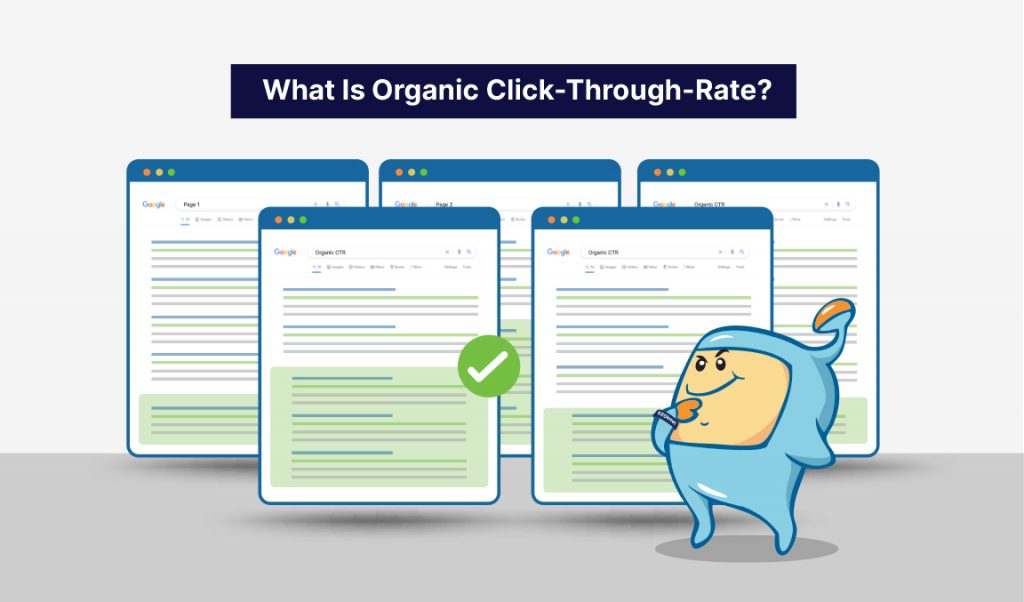
Did you know that while a click-through rate is often connected with pay-per-click advertising, it is also used in organic search and search engine optimization?
Organic click through rate or Organic CTR is the particular percentage of searchers that click on your search result. It is the number of clicks a search result receives, divided by the number of times it shows up in the SERPs (Impressions).
As mentioned earlier, a site’s organic CTR is highly based on its position in the search results page. The higher the ranking, the better the organic CTR. However, there are different ways to influence CTR. Examples are the use of effective Title tags, meta-description, url, and the different SERP features (Rich Snippets, Featured Snippets, Site Links, etc.)
Check out our article on the different SERP features and ways on how to get them to show up for your site for more details.

Organic CTR is important, mainly due to two factors – traffic and rankings.
The higher your organic click through rate is, the more traffic you get to your site. By making improvements in your CTR, the more traffic you get to your site. For instance, increasing your CTR from 5% to 10% effectively doubles your search engine traffic.
While CTR is highly correlated to your ranking position, it is possible to increase your organic CTR without increasing your ranking position. For example, if you are in the 2nd or 3rd position, you have the ability to surpass the page on the first position simply by having better page titles and meta-description. While the top position is the ideal, you can get more traffic by optimizing how your page shows up in the search results and making it enticing to click on compared to others.
Second, is your page and site’s rankings in Google. CTR is said to be a ranking factor. This means that the more that people click on your site, the better chance that it would rank higher in search as this shows Google that users are clicking on your site – they find your content useful to what they are searching for. If people are not clicking on your site then it would show Google your content is not useful and may lower your ranking down in search in favor to ones that are getting those clicks.
There are mixed opinions with regards to CTR and rank. However, a Google engineer has said that they use CTR to figure out what type of results users want to see in an SMX talk:
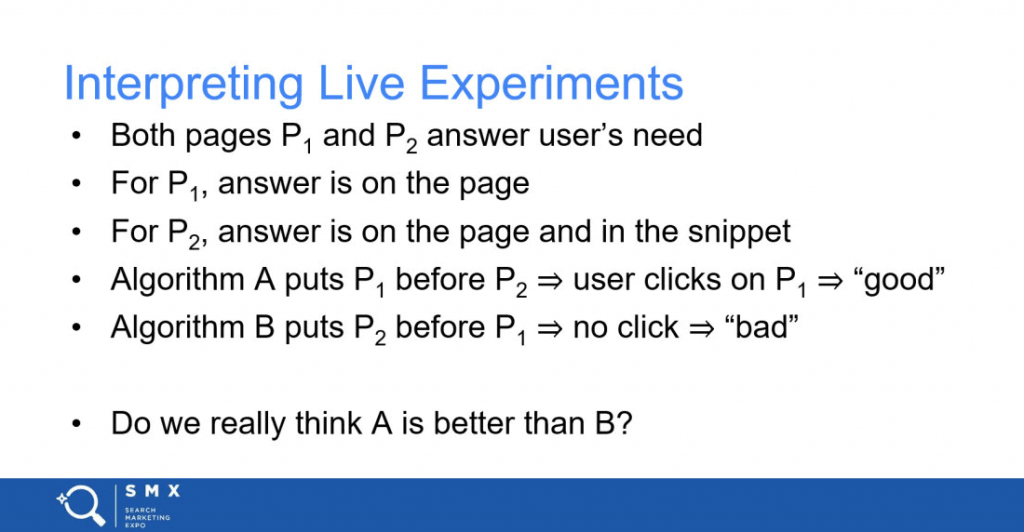
One thing you should know is that you have complete control over your CTR and you can make adjustments to it.
Danny Sullivan also tweeted an FTC proceeding where Google said that they use CTR as a ranking signal:
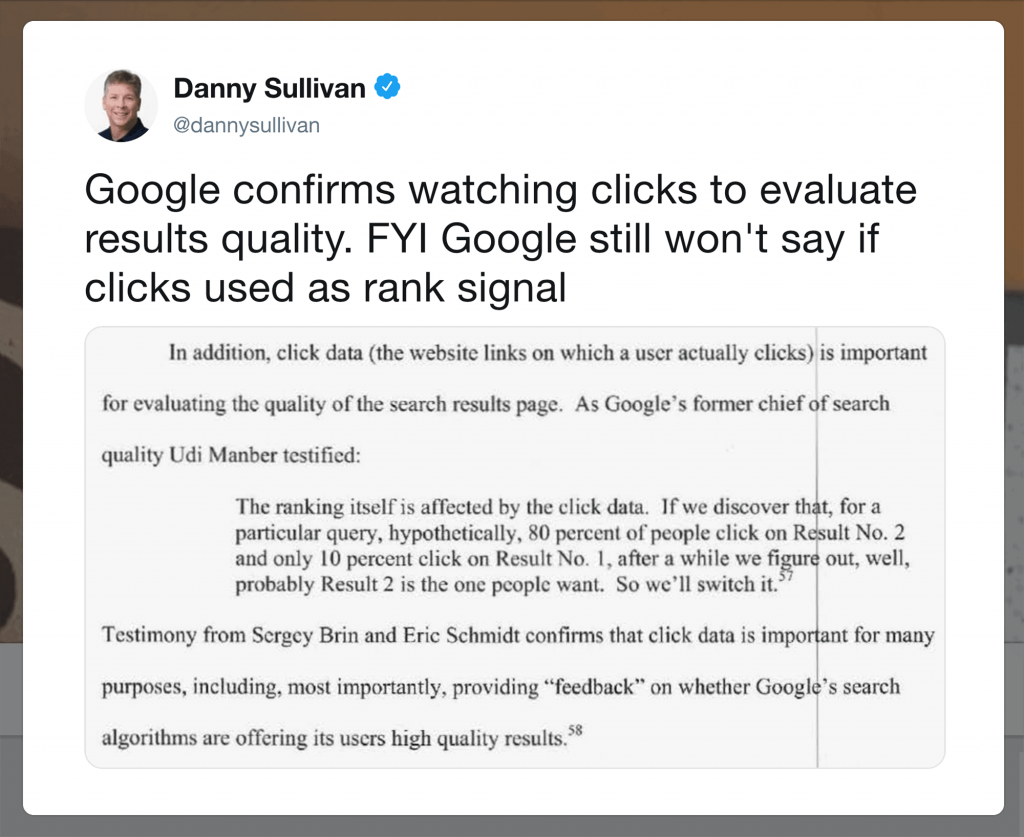
Source: Backlinko
Though Google did not outrightly confirm that it is a ranking signal, there’s no harm in making changes and improving your CTR as this would help you get more traffic to your site, which is a win, in and of itself.

Calculating your organic CTRs enables you to assess the relative worth of each rank position for your website as no rank is created equal. Additionally, it enables you to estimate organic site traffic; for example, a drop from position two to position eight may lead to a 42 percent reduction in traffic for that phrase.
Additionally, once you have a general sense of the volume of traffic your website receives, you can gauge the success of your efforts by setting reasonable goals for the return on investment (ROI) of your initiatives, campaigns, content, and site updates.
Do recent campaigns meet expectations? Does changing meta descriptions and titles increase click-throughs? All of the information will aid in your understanding of your target market, including their interests and behavior.
So how can we say it’s a good score?
When there are less non-organic SERP results like Ads and Image Packs, it means that the search result has a higher organic CTR, which increases your chances of ranking organically. 100 is the desired number if you solely perform traditional SEO using 10 blue links. However, keep in mind that lower Organic CTR ratings can be used to find additional SEO chances. If you’re optimizing for SERP features and you show up in a featured snippet, the image block, top stories, or any of those other places, you’d definitely be overjoyed to learn that CTR was going to those non-web results parts, and scores in the 40s or 50s would be fantastic.
Note that even if a keyword has a lower Organic CTR score, you shouldn’t automatically ignore it. It’s a sign that other SERP Features might exist and ought to be looked at further. Who knows, you might be in a good position to get featured snippets or target other features like images or videos if you’re performing well for that keyword.

Although a click-through rate has various applications, it also has some notable drawbacks:
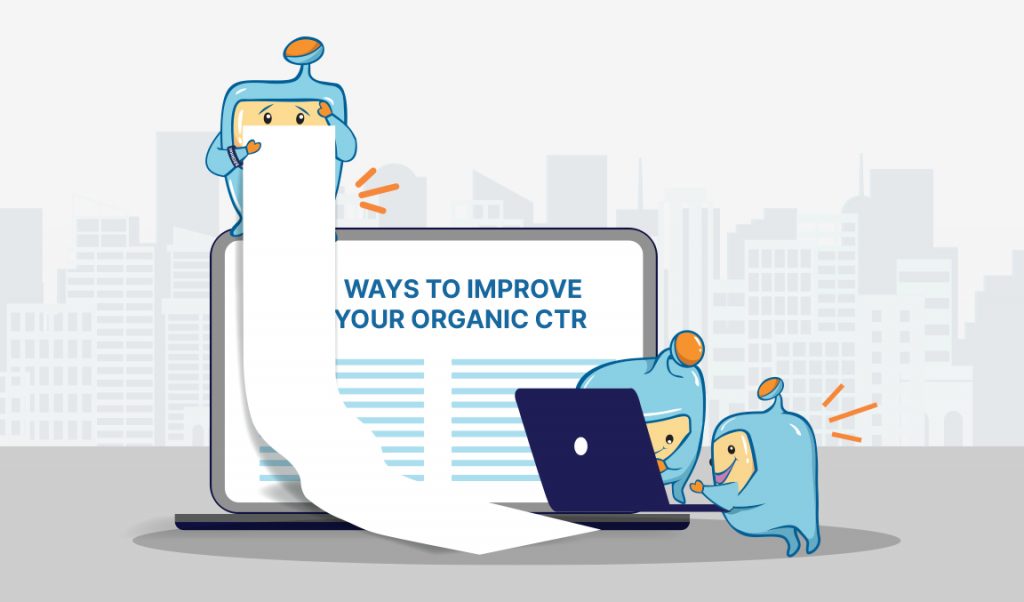
A CTR is an intricate, erratic SEO beast. Only a few of the variables that could affect it are listed below, so make sure to take note of these best practices if you want to win the race!
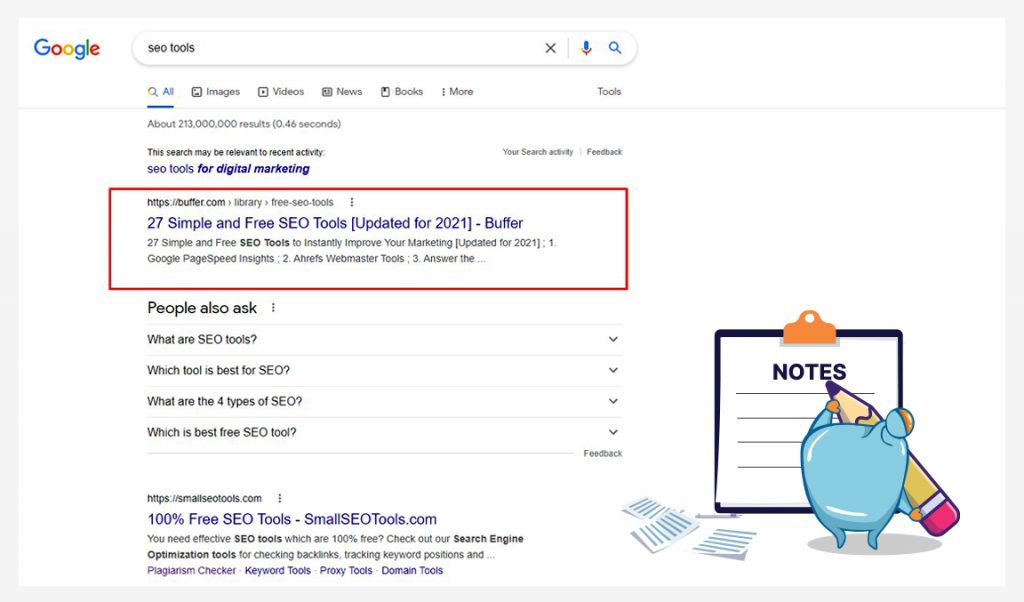
Make your title tag interesting through using brackets. Your post title will be more likely to be clicked on if it contains brackets. Additionally, it can shorten and make titles look more interesting.
According to HubSpot, brackets can boost headline clicks by 40%. Listicle-heavy websites like Buzzfeed have become so famous for a reason, and a large part of it is due to the potency of their intriguing headlines.
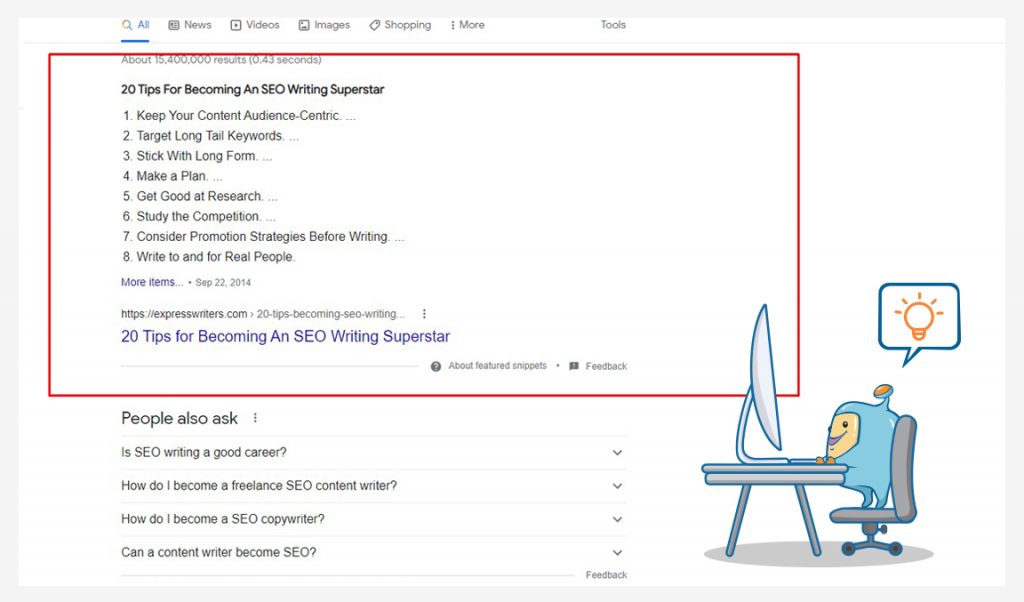
Your existing content ought to be converted into a list post, if at all possible. List postings are easier for readers to read and more engaging. Even if your post isn’t a list post, you should make an effort to utilize numbers in your title wherever you can.
The search results also display the URL of your page. You should already be using short URLs that contain your target keyword for proper onsite optimization.
However, if you continue to use lengthy URLs, now is the moment to optimize them.
Your URL is a further component that displays in your search engine listing along with your title and meta description. This is an opportunity to add long-tail search-related keywords.
The main objective of your search engine listing is to reassure the user that your page is the most pertinent to their query.
The factors listed below are all factors in the search results you receive; how long is your URL?
the URL route (the navigation path to your ranking page) and the categories available if there’s any.
We have discussed before when creating a URL we need to consider that it is search engine friendly. The front of the URL should contain your target keyword. Also, your URL should be brief and finally, remove irrelevant elements from your URL, such as the date, the author’s name, and long URL strings.
Even if it isn’t as crucial as your title tag, your meta description still has a massive impact on organic CTR. With that said, here is a description writing guide that will encourage visitors to click.
Be Emotional: People are drawn to descriptions that evoke emotion. You don’t have to be shocking or attention-grabbing. But in your description, don’t be scared to use strong adjectives like “wonderful” and “powerful.”
Watch out for the description’s character limit and keep it within it (approximately 150-170 characters).
Sell Your Content: On Google’s first page, your page is up against 9 organic search results. Don’t be hesitant to explain to folks why they should look at your outcome.
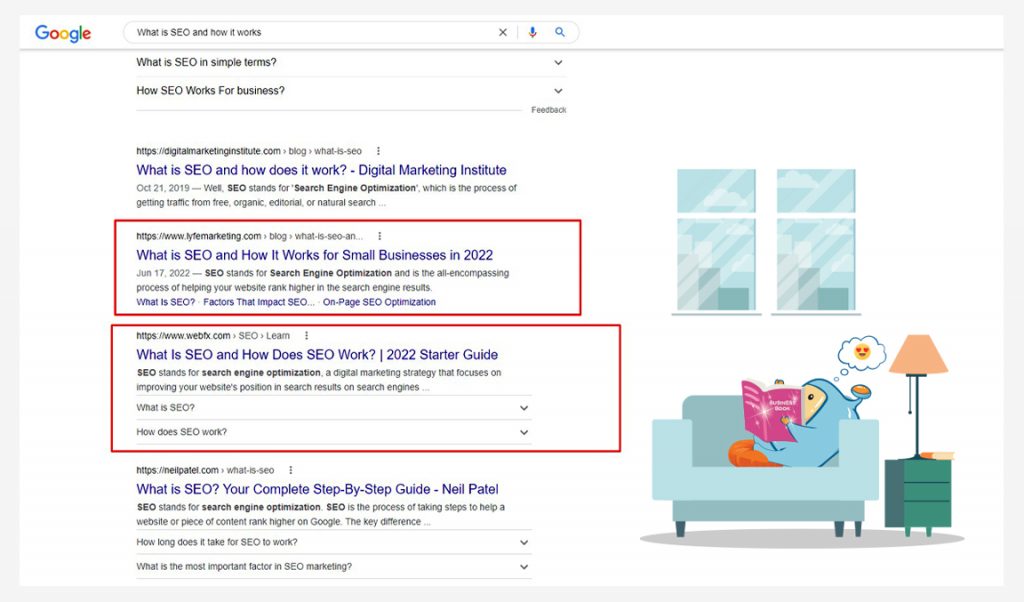
Every day, new tactics are introduced to the field of online marketing. The fact that “2021” appears in both your title and description indicates that your content is current.
As mentioned from the last article about pogo sticking, users enter a site that over promises and under delivers in this scenario. To put it another way, the searcher comes across clickbait content.
Here some of it that we usually see such web content and regretted clicking on: “You’ll Never Believe This (…),”, “Do This One Thing for 2 Weeks and (…),”, “They Don’t Want You to Know This (…),” and so on. When we do, we feel duped and “pogo” back to the SERP.
With this type of title tag, you will surely get visitors but is it worth it?
No!
Your bounce rate will soar as a result but kill’s your dwell time as well which can severely damage your Google rankings. So promote your stuff without overselling it.
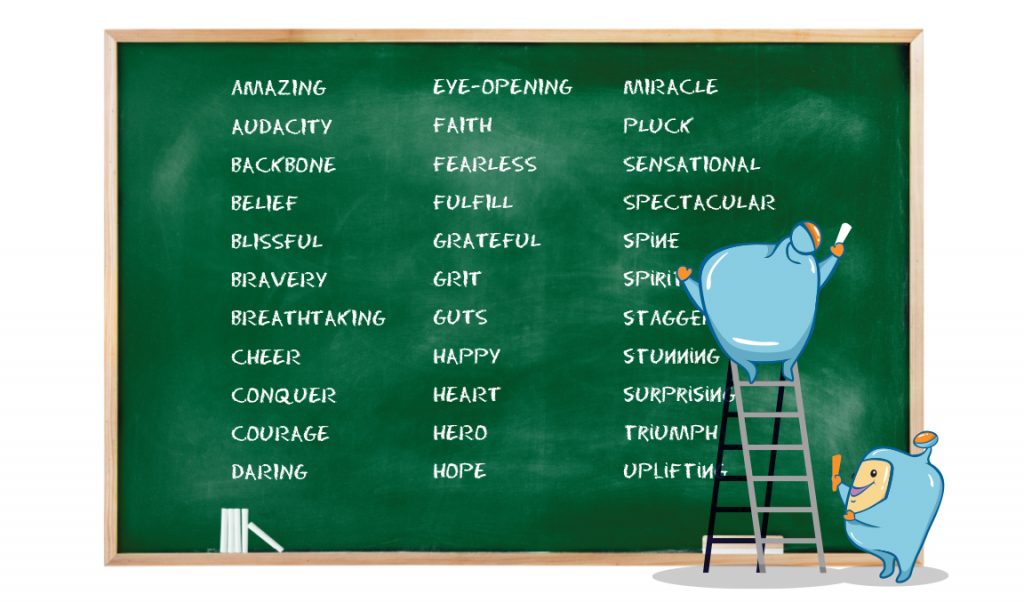
Power phrases that appeal to readers’ emotions should be used in your title. These include adjectives like astonishing, amazing, secret, extraordinary, and more.
Two of the best techniques to raise your organic click-through rate are rich snippets and sitelinks and a structured markup can actually boost organic CTR by 30%, according to a Search Engine Land study.
Rich snippets are essentially improved search results. The typical search outcomes are as follows; Title, URL, and meta description.
Rich snippets can provide more information to a page, such as; Ratings, pricing details, images, reviews web page icon and website name.
Note that Google also improves the look of search engines in the following ways like the site improvements which may consist of a search box or links to the pages a website contains. Also the knowledge graph that provides information about a subject, brand, or celebrity and frequently includes a description, links to social media, and other things.
Remember, if your competitors are not utilizing rich snippets, you will stick out in the search results.
Meanwhile, Sitelinks are another method for enhancing your search engine visibility. Sitelinks, which point to other pages on your website, are displayed in the search results underneath your meta description.
Sitelinks aid in expanding the amount of room occupied by your search engine listing, which increases visibility and CTR. Having sitelinks can also result in a better user experience because your visitors can go straight to the most pertinent page.
Since Google doesn’t display sitelinks for every website, it’s also an indicator that it trusts your website. Also, Sitelinks cannot be directly specified because Google’s algorithm will decide which sitelinks are most pertinent in its opinion.
However, you can contribute to affecting whether sitelinks appear in the search results.
Sitelinks can show up when visitors search for your company name or even directly beneath specific content.
This would make the user read and access the information they are looking for.
Simply make a table of contents about your article then link it to the section where it talks about the content. This would also enhance the user’s experience on your website. But these sitelinks also aid Google in recognizing the various parts of my page.
Your first opportunity to persuade readers to click on your story is in the title. You must make sure it connects with your target audience because it has such a crucial role.
A headline analyzer removes a lot of the uncertainty involved in creating killer title tags.
You may use Coschedule Headline Analyzer.

The best way to increase conversion rates is to build a brand that people in your industry know, like, and trust.
Facebook advertising is one of the quickest ways to quicken this process. That’s because Facebook advertisements may instantly expose your brand to a large number of people.
Retargeting should be your primary concern. It promotes your website to those who have already visited it and is reasonably inexpensive.
And when these people view your advertisements often, it strengthens your brand in their minds.
They will therefore skip past the results that are listed above you the next time they see your brand in Google’s search results and go straight to your website.
One crucial aspect of SEO that is mostly in your control is your organic CTR. Although enhancing your search engine listing takes less time and can still yield amazing benefits, many SEO-related tasks demand a lot of labor.
If you don’t optimize your search engine listings, you could be losing out on potential visitors that you could get with a few changes.
You have to always mind that organic CTR is essential to the accomplishment of your digital marketing initiatives. Customers are entering for “free” to look around your store, brand, goods, and services. As a result, you should give content optimization top importance.
For website and business owners, increasing CTRs is no longer a problem thanks to the abundance of choices available. Additionally, the outcomes are undeniably worthwhile and speak for themselves.
Once you have mastered the best practices, you can run retargeting advertisements to users who have already been to your website to persuade them to click your search engine listing, regardless of where you happen to rank.
Although it won’t happen overnight, increasing your CTRs is a useful optimization task that can help your rankings and traffic in general.